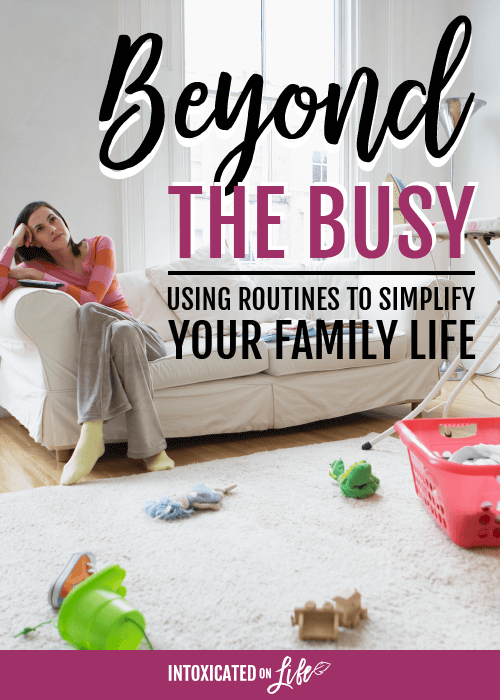When I was a brand-new mom, I came across a book that advocated getting your infant on a schedule as soon as possible, preferably within the first few weeks of their life.
At first, this sounded like a great idea to me. Though I was utterly in love with her, I wasn’t really a fan of the way this tiny bundle had completely upended every single thing about my life – especially when it came to my beloved sleep. Plus, when she was about three weeks old, she suffered from colic, and I was willing to try anything to help us both cope just a little better with life.
It wasn’t long before I came to realize that while establishing an infant’s schedule could be helpful for some moms, I wasn’t that mom. I didn’t have to rush out the door at a particular time every day. At that point, I didn’t even have to consider the schedules of other kids in the house.
It was freeing to take back the truth that as a stay-at-home mom, I was free to be flexible. And that’s when I began to understand the power of routines.
Why Your Family Needs Routines
As my kids have grown and their number has expanded, routines have become even more important. They were essential during our homeschooling years, and are just as critical now that the kids are attending a Christian school. Here are just a few reasons why:
- They keep life on track. Routines help us make sure that important daily tasks are attended to, and they manage to do so without the pressure of conforming to a clock.
- They establish order. Having familiar expectations and establishing order throughout the day bring a sense of predictability and security to kids, which helps create a calm atmosphere.
- They teach kids responsibility. As kids become acquainted with routines, they learn to handle them on their own, instilling confidence and initiative.
- They save your sanity. Routines essentially automate life, saving you (and your kids!) from countless reminders and frustrations.
5 Steps to Building Custom Routines For Your Family
It’s not hard to come up with routines for your family. These five simple steps will get you well on your way:
1. Think about what you want them to do.
What repetitive tasks need to be accomplished each day? What do you frequently have to remind them to do? To get you started, I’ve included some suggested tasks for each routine in the next section.
2. Establish when you want them to do it.
What time of day does the routine need to be done? How does the family schedule (school, work, meal times) impact the routine? Would it be helpful to use a timer for certain routines?
3. Post the routine.
Once you have a clear idea of what a routine should look like and when it should be accomplished, write it down. If each child has a different routine, write a separate one for each child and post it in a visible location (or two locations, if a routine includes tasks in two different areas in the home).
4. Teach the routine.
Tell your children about the routines, explaining how you think routines will benefit them. Go through each task in the routine and make sure your expectations are very clear and the routines are within each child’s abilities. Make adjustments as necessary.
5. Practice.
Expect to give several reminders as kids are learning the routine. Try to point them to the posted routine as much as possible, rather than giving specific instructions.
Essential Routines for Your Family
Now that you have an idea of how to create routines for your family, here are five must-have routines that keep my family on track.
Morning routine
This routine covers those tasks that are necessary from the time kids wake up in the morning, extending as far into the morning as necessary.
Suggested tasks: greeting God and welcoming Him into your day, making beds, straightening bedrooms, personal hygiene (list these tasks individually for young children), emptying dishwasher, preparing/eating breakfast, cleaning up from breakfast, leaving for school/starting homeschool work
Afternoon routine
This routine can start with lunch if your kids are at home, or it can be delayed until after they get home from school. It can cover tasks up to dinner time.
Suggested tasks: having lunch, cleaning up from lunch, completing homeschool work, eating a snack, completing homework, practicing instruments, playing outside for 30 minutes, reading for 30 minutes, helping with dinner prep, completing age-appropriate chores
Bedtime routine
This routine can begin as early as post-dinnertime, and extends to the child’s bedtime.
Suggested tasks: age-appropriate chores, packing lunch for the next day, setting out clothes for the next day, personal hygiene (list these tasks individually for young children), reading, personal devotions
Weekend routine
A weekend routine allows you to accommodate what is often a different schedule from weekdays. At our house, much of the morning, afternoon, and bedtime routines remain in effect, with the addition of special Saturday chores and the removal of a few non-essentials on Sunday.
The point is to shape the routines to suit your family’s needs. Remember: routines are a tool, not a master!
Worship routine
Incorporating worship into daily and weekly routines reinforces to kids that faith is of primary importance to your family; you love and serve a God who wants to be included in your lives; and He deserves your time, your devotion, and your worship.
Daily personal worship: Encourage each member of the family to make time for personal devotions each day, as appropriate for their ages.
Daily family worship: Set aside a few minutes each day for family Bible-reading, prayer, and discussion. There’s no wrong way to do this, so get rid of your preconceived ideas about what it should look like, and just do it!
Weekly corporate worship: The frequency of local church attendance will vary from family to family – some may attend on Sunday mornings only, others may be present any time the doors are open. What’s most important is to be intentional in deciding which services your family will take part in. It sends a powerful message to your kids when you’re faithful to that commitment, refusing to let other activities interfere.
Final Thoughts
If these types of routines are fairly new to your family, it’s a good idea to start small. Pick one of the above routines that will be the easiest to implement, or the one your family most needs. Then mark your calendar (and bookmark this post!) so you don’t forget to add a new routine every couple of weeks.
Above all, be patient. Learning routines takes frequent reminders and lots of practice, but trust me – it’s time and effort very well-spent!
We’d love to hear from you! What kinds of routines do you implement in your home? Which one of these routines does your family most need right now? Join the discussion by leaving a comment below.












Leave a Comment